The inhabitants of the Maslyaninsky district in the Novosibirsk region firmly believe that no one will ever stumble upon a meteorite. This is because, once every few years, rare meteorites composed of iron with silicate inclusions are discovered in one of the fields near the village of Malaya Tomka. Scientists also suggest that there may be more of these extraordinary finds in the future. Not only are these meteorites incredibly valuable from a scientific perspective, but they are also astronomically expensive, worth millions of rubles in today’s currency.
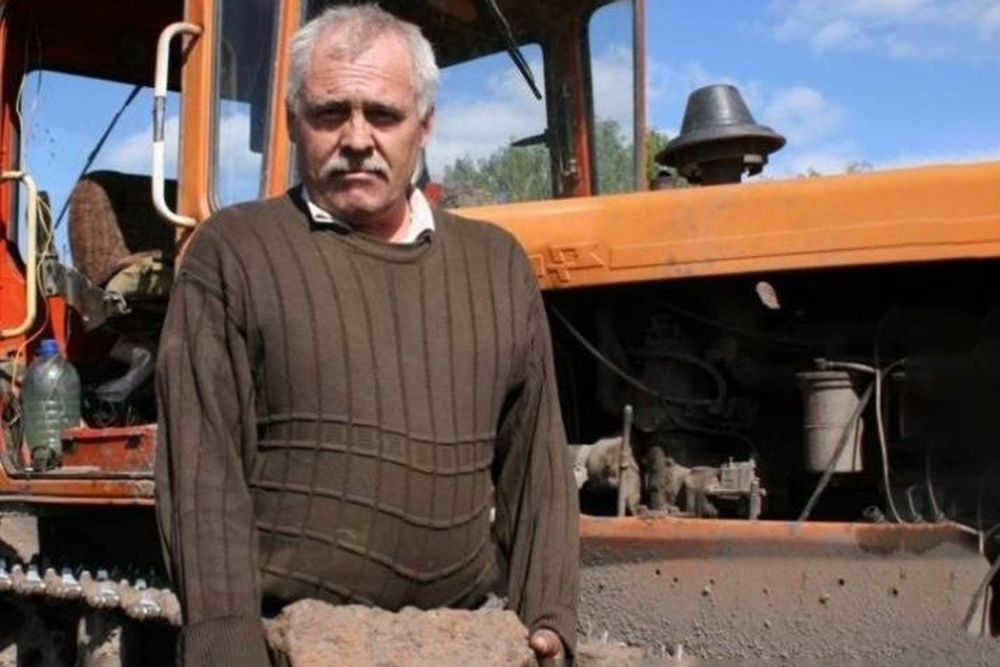
Tractor driver Gennady Bazylev, who works on a large dairy farm, had the lucky chance of discovering not just one, but two meteorites. However, he decided not to publicly share information about the second meteorite. This remarkable find was reported by webmineral.ru.
Unfortunately, luck was not on the side of the correspondent from “RG”. As much as I wished for money to fall from the sky, all I could find on this famous field were cornflowers and alfalfa. These plants are cultivated by the dairy farm. The only remnants of what could have been a meteorite were a few scattered pieces of rubble. My hopes were finally dashed when Vladimir Okel, the person responsible for the meteorite discovery, revealed that the stones were brought along with the humus that was used in the field. In 1992, Okel generously handed over the meteorite, which was subsequently named “Maslyanino”, to geologists.
The top spot belongs to Vladimir Okel
Several months later, the agronomist himself was discovered. The meteorite made its way to the team of the now-defunct Commission on Meteorites and Cosmic Dust at SB RAS, and they needed to determine its exact origin. This became a detective story: with the help of the police, Vladimir Okel managed to track down the cooks who remembered the type of car he used to transport the meteorite. As a result, the scientific community obtained the necessary information (leading to a number of scientific articles on the “Maslyanino” meteorite), and Vladimir Okel received two letters of gratitude from scientists, souvenirs from the geological museum, and, as he himself puts it, a deep sense of moral fulfillment.
Subsequently, a portion of the Okel meteorite made its way to Moscow – the owner possesses a document stating that his discovery is officially registered as number 186 in the Committee on Meteorites of the Russian Academy of Sciences. Furthermore, he has been informed that there are only a total of 26 similar findings documented worldwide! As a gesture of exchange, the Moscow colleagues at the Central Siberian Geological Museum graciously presented him with a fragment of the Mundrabilla meteorite, which was discovered in Australia.

Vladimir Okel, the discoverer of the meteorite, wishes to give it a proper name, and why shouldn’t he? Photo: Nina Ruzanova
By the way, let’s consider the theory that the meteorite was meant to be found. There is something worth pondering. A few years after Vladimir Okel unearthed the extraterrestrial object, he changed his career path – at the age of 47, he earned a diploma from the Pedagogical University and now works as a history teacher at a school in the village of Nikonovo. Meanwhile, his daughter Lyudmila serves in one of the prestigious musical theaters in St. Petersburg. From a remote Siberian village, she has achieved success in the field of academic vocals, participating in competitions and winning prizes. It just goes to show how rewarding it can be, you might say.

Scientists have released a number of articles on the Siberian meteorite, analyzing its chemical composition. Photo: Nina Ruzanova
The Bazylev Brothers – Numbers Two and Three
Gennady Bazylev worked as a tractor driver. He became the “guest from outer space” on the same field in 2007, which is 15 years after the discovery of Okel. His brother Sergei served as the manager. It was already the 21st century, and the brothers were doing well: they were not willing to give away the meteorite for free. After doing some research online, they dreamed of making millions of dollars.
However, the plans had to be revised. Selling meteorites abroad is expensive and difficult due to permits and expert opinions. As a result, the meteorite discovery remained in Russia. What few people know is that there were actually two meteorites at Bazylevy. The larger one is now on display at the Central Siberian Geological Museum, while the second one, a beautiful 19-kilogram specimen, was sold to a private collector.
The current rates for “celestial stones” can reach 25 U.S. dollars per gram of meteoritic substance, and this is just the beginning.
It is uncertain how much the brothers received for their meteorites. However, Vladimir recalls that work on the farm halted for a week as the tractor driver and his fellow workers celebrated their cosmic discovery.
Number four – Tatiana Odegova
The following extraterrestrial visitor made an appearance in Malaya Tomka approximately six years later, in 2013. It happened in the same field, or more precisely, at its border. Tatyana’s son was busy crafting brooms while she was busy picking strawberries. Suddenly, she stumbled upon a stone.
“Do you see how I’ve used stones to enclose my flowerbeds?” Tatiana explains. “I intended to take this particular stone, but it turned out to be quite heavy. In that moment, a thought flashed through my mind: ‘Meteorite!’ It was a completely unexpected notion for me.”
Tatyana’s family immediately valued the discovery at one million rubles. No need to worry, it’s such a stroke of luck. Vladimir Okel and I both nodded in approval and offered our support. If Okel had found the meteorite now, he probably wouldn’t have handed it over to the geologists either. Tatyana’s sister-in-law found collectors on the Internet, and the meteorite was quickly acquired by the enigmatic “men from Altai” – as they say, it didn’t stay on the market for long. It is now being kept in someone’s private collection – there is no information that another specimen of the meteorite has surfaced in any of the museums.
What do we know about meteorites?
Iron and iron-stone meteorites make up only about seven percent of the total number. It is estimated that every year, between two and six thousand tons of debris from celestial bodies, mostly in the form of fine dust, fall to Earth. This makes the discovery of the Maslyanino meteorite a truly rare occurrence.
What is the Cost?
When it comes to the price, meteorites can be quite expensive. For instance, the “Seimchan” meteorite from the Magadan region currently costs around $2.5 per gram, while the Mexican “Allende” meteorite can cost between $20 and $25. Those fortunate enough to purchase 30 kilograms of meteorites from Tatiana Odegova can easily make a living by trading the thin plates – that’s the nature of their business. As for the legality of owning meteorites, opinions are divided. Some argue that according to the “On Subsoil” Law, meteorites are considered state property. However, this law defines subsoil as “below the soil layer” without specifying the exact depth in meters. In any case, if you happen to find a meteorite on the surface, it is legally yours to keep.
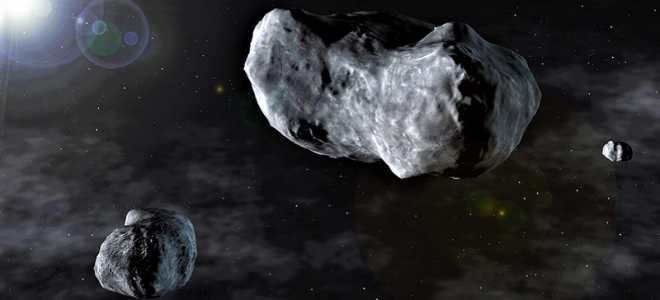

A considerable number of scientists hold the view that the celestial body responsible for the extinction of dinosaurs on our planet was an asteroid. According to estimations, its diameter was between 10 and 15 kilometers. In fact, the collision resulted in the formation of an impact crater, which is ranked as one of the biggest depressions on Earth caused by extraterrestrial objects.
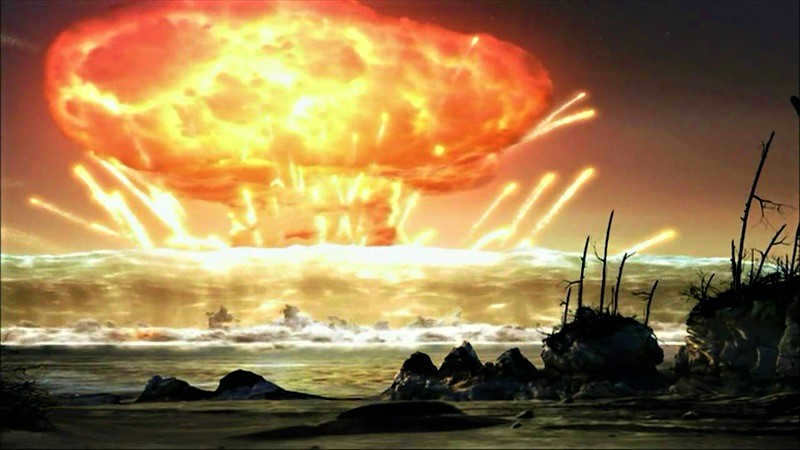
The moment the meteorite responsible for the extinction of the dinosaurs landed.
It was discovered that during the late Cretaceous period, approximately 65-66 million years ago, our planet experienced a collision with an asteroid. According to scientific analysis and calculations, the asteroid approached the Earth at an angle exceeding 60 degrees in relation to the horizon, with its trajectory originating from the northeast and ending on the Earth’s surface.
Where was the location of the meteorite impact that led to the extinction of the dinosaurs?
For a considerable amount of time, there was a great deal of controversy and speculation surrounding the theory that the dinosaurs were wiped out by a meteorite.
It wasn’t until 1991 that geologists discovered a crater on the Yucatan Peninsula in southern Mexico, finally confirming this hypothesis. This crater was named Chicxulub, after the nearest city to its location. It is estimated to have a diameter of 180 kilometers and a depth of up to 20 kilometers. Due to its deep underground nature, it was a challenging discovery to make.
Initially, geophysical surveys identified a depression at the bottom of the Gulf of Mexico, which led to the realization that the crater extended onto the land in the northwest of the Yucatan Peninsula.
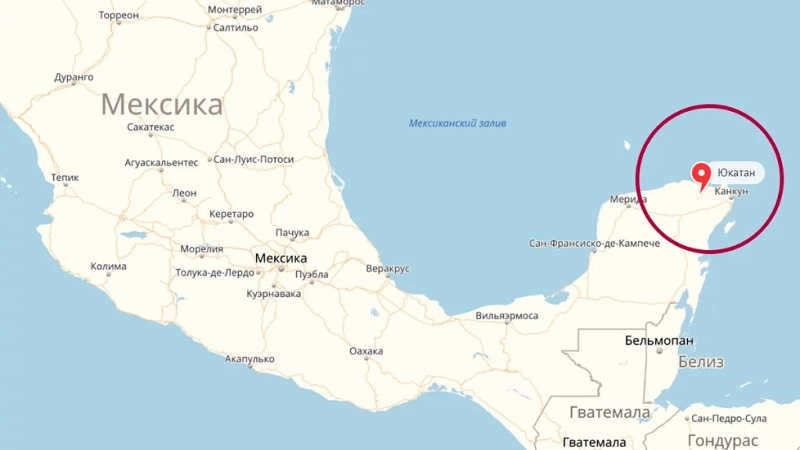
The unique characteristic rocks and gravitational anomaly inside the structure have unveiled the cosmic origin of the deepening on the surface. Further confirmation of this large crater’s causes came from chemical analysis of soils and detailed imaging from space.
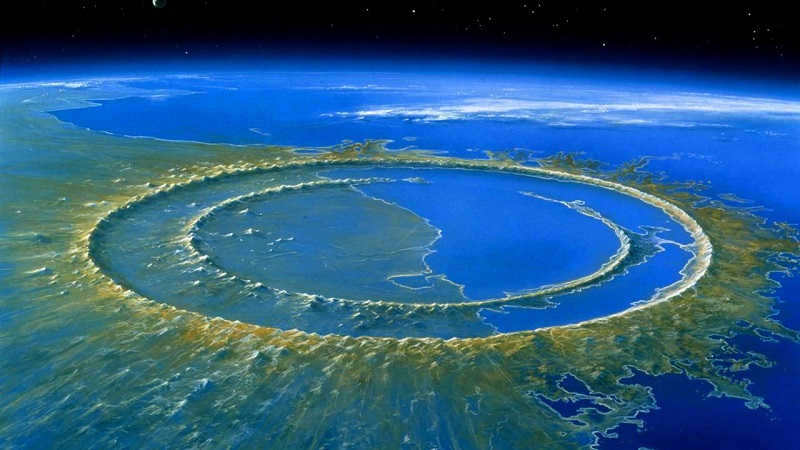
Impact of the asteroid collision with Earth
Through extensive research on the Gulf of Mexico’s seabed and the resulting crater, geologists have developed a precise model of the asteroid and determined the angle of its impact.
It is important to highlight that this event posed the greatest threat to our planet, as it occurred during a time when the Earth’s atmosphere contained a significant amount of dust. Upon impact, the meteorite dispersed this dust particles all over the globe, resulting in a nuclear winter-like scenario.
In fact, the energy released from the explosion of the asteroid body is estimated to be equivalent to 100 trillion tons of TNT.
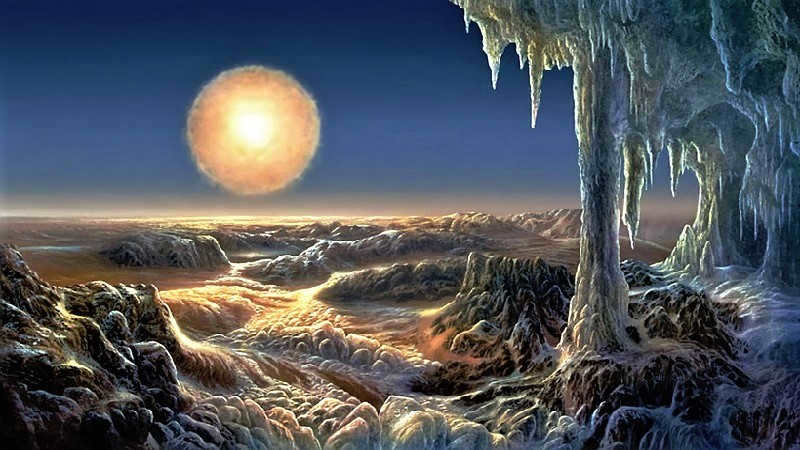
What occurred during the process? Initially, shockwaves propagated in all directions, causing massive tsunamis, earthquakes (10 points), and a meteor shower. However, these events did not lead to the extinction of life.
Subsequently, when the asteroid collided with Earth, a significant portion of the planet’s crust vaporized and rose into the upper layers of the atmosphere. Eventually, it reformed as glass droplets. This is due to the gravitational bond between the crust and the planet itself. The crust was moving at an incredibly high velocity, resulting in the heating of the atmosphere. Consequently, a global conflagration ensued, and the soot and dust generated by the collision obstructed the sun’s rays from penetrating, leading to worldwide darkness and gloom.
Months passed, and the Earth experienced a continuous shower of asteroid dust. This marked the commencement of a remarkable era known as the Cretaceous-Paleogene boundary. Even to this day, remnants of the Cretaceous-Paleogene layers can be found on the Earth’s surface, captivating the attention of scientists.

Life on Earth following the cataclysm
Scientists believe that a portion of the Earth’s flora and fauna perished as a result of extreme heat, powerful winds, earthquakes, tsunamis, and the impact of meteorite fragments. Meanwhile, another segment of the ecosystem suffered from a lack of sunlight, which led to a scarcity of food and water due to the absence of photosynthesis. Consequently, numerous food chains were disrupted and destroyed.
It can be argued that living organisms either perished in flames or starved to death. However, some small species managed to survive under these incredibly challenging circumstances. They were able to adapt, to some extent, to the new conditions, if one could even call them conditions at all.
Nevertheless, over time, the process of recovery and rejuvenation of the planet commenced. Of course, this process spanned many years, even hundreds and thousands of years.
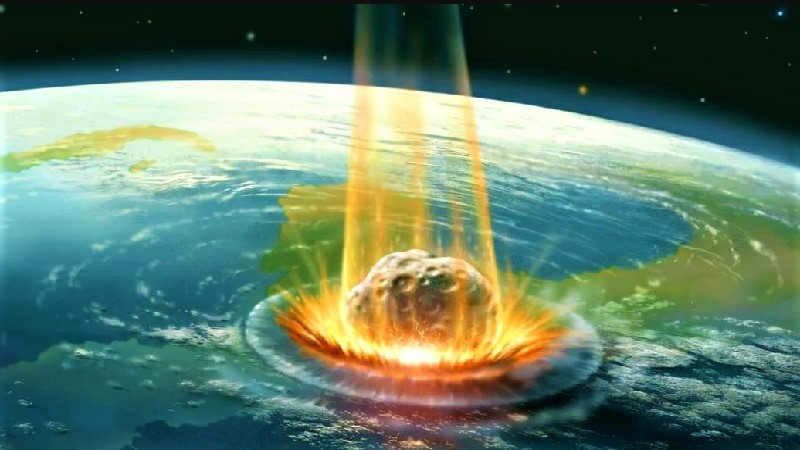
Fortunately, the extinction event caused by the meteorite that wiped out the dinosaurs did not spell the end of life on our planet. The disappearance of the dinosaurs paved the way for the emergence of new ecological elements and organisms, resulting in the abundance of mammals and plant life that we witness today.
The cataclysmic impact of the meteorite that brought about the demise of the dinosaurs also gave rise to the evolution of other life forms. It is safe to say that such cosmic falls and disasters have not only been tragic events, but have also presented new opportunities. Undoubtedly, they have played a crucial role in shaping the course of evolution globally and across all domains.
Scientific research indicates that this asteroid, which caused the destruction and extinction of a large portion of the Earth’s flora and fauna, stands as the most devastating and catastrophic episode in the history of our planet’s existence.
This momentous event is directly responsible for the world we see around us today. It is quite possible that it is because of this event that our species, you and I, came into existence in the first place.
Undoubtedly, we must maintain a positive outlook, as everything that happens is ultimately for the best! However, let us pray that our planet never experiences a similar situation in the years to come.

Exactly a decade ago, on February 15, 2013, an extraordinary event occurred in the Chelyabinsk region as a meteorite descended from space. This incident holds the distinction of being the most extensively documented case of a celestial object crashing into our planet. The resulting shock wave caused widespread damage, shattering windows in countless homes, hospitals, schools, and kindergartens. Over 1,500 residents of the Southern Urals suffered cuts and bruises, and fragments of the exploded meteorite showered down on the outskirts of Chelyabinsk. However, the situation could have been far more dire, potentially reaching catastrophic proportions akin to a nuclear disaster. Lenta.ru’s special correspondent, Sergei Lyutykh, embarked on a journey to the Chelyabinsk region to interview those who bore witness to the meteorite’s fall and examined the aftermath.
On the morning of Friday, February 15, 2013, Alexander Kharlamov and his colleagues held a training session with a group of 20 children. They gathered in the dry hall of the “Stroitel” pool to practice diving technique.
The training session was progressing normally until around 9:20 when a sudden burst of light caught everyone’s attention. The children instinctively rushed towards the large windows of the hall to see what was happening outside. However, Alexander Egorovich, an experienced coach with almost four decades of coaching experience, quickly intervened and ushered the children to the back of the hall for safety.
When the explosion occurred, fragments were propelled into the room. The trainers used practice mats to shield the children, but two individuals were still in the danger zone. Kharlamov immediately went to their aid, providing cover by using his own body and absorbing the impact of the shrapnel. He then collapsed to the ground along with the children. Fortunately, the glass shattered horizontally, which minimized the harm.
Kharlamov was drenched in blood. He somehow managed to lift the boys who were seeking refuge beneath him and helped them evacuate.
His arms, back, head, and most importantly, the tendons in his legs were lacerated. He took a few unsteady steps in a daze before ultimately collapsing and losing the ability to move on his own.
Finally, only one of the boys ended up with a piece of shrapnel lodged in his foot. The injury required stitches, and Kharlamov was transported to the hospital, where surgeons diligently attended to him. The coach suffered severe injuries and had to undergo multiple surgeries in order to regain mobility in his feet.

In Chelyabinsk and the surrounding area, it was the children who faced the most perilous situation – in school offices, kindergarten rooms, sports halls of sections, and every other place with multiple windows. Elena Ponomareva, the deputy director of Kindergarten No. 7 in Kopeysk, along with coach Kharlamov, shielded the children in the nursery group. Meanwhile, Elena Skomorokhova, the head of Kopeysk Kindergarten No. 25, who was injured by shrapnel, bravely held onto the window frame that was torn out by the shock wave, preventing it from falling onto the students.
There were sufficient individuals among the educators in the Urals who had not forgotten about the lessons on civil defense in a timely manner. For instance, Yulia Karbysheva, who is a primary school teacher at Lyceum No. 37 in Chelyabinsk, instructed 44 students to seek shelter beneath their desks when the explosion occurred, although she herself sustained serious injuries. Rashit Sultanov, who serves as the director of Orphanage No. 2 in Korkin, not only managed to remove curious students and staff from the vicinity of the windows, but also successfully evacuated them outdoors before the shockwave reached them – it only took him a couple of minutes to accomplish this.
The victims were transported to hospitals, which were devoid of any windows. “I was seated in the trauma ward corridor on a bench sandwiched between two sizable windows when they were simultaneously shattered,” recounts Pavel Tretyakov. – The shards momentarily hung in the air, filling the entire room, reminiscent of scenes from Guy Ritchie movies”. Tretyakov, who was just 11 years old at the time, recalls feeling like the protagonist in an unexpected action film.
Moments earlier, a woman with a fractured leg had entered the ward. Amidst the ensuing chaos, Tretyakov noticed her crawling on all fours towards the exit in sheer terror.
All emergency systems within the hospital were triggered. A siren blared, and the ward grew immediately chilly.
It was a frigid day on the street, with the temperature plummeting to approximately minus 20 degrees Celsius. The fortunate individual in question was accompanied by his grandmother, and they had wisely decided against leaving their jackets in the checkroom. As a result, they were able to swiftly bundle up to protect themselves from the bitter cold. While the young man himself managed to avoid any harm from the flying shards of glass, he witnessed firsthand the devastating effects as they tore through patients and doctors near the windows of the doctor’s offices. Upon returning home, the boy was dismayed to discover that the force of the explosion had also blown out the windows of his own residence.

According to Ivan Kolotilov, a villager from Deputatsky, the glass shards caused more harm than the small meteorite fragments that fell in the Chelyabinsk region. He claims that these celestial pebbles were only able to penetrate an old slate roof, but not a metal roof. Fortunately, the residential buildings remained undamaged.
Thousands of individuals, located far from the epicenter, experienced the impact of the air shockwave. Ivan Kolotilov, who was situated 50 kilometers away from the village of Yetkul where the meteorite detonated, vividly described the event by saying, “My pants were trembling.”

Chebarkul witnessed the bolide’s final flight and the largest meteorite fragment landing, presenting a different perspective compared to Chelyabinsk. Alexander Zagreba, a local resident, observed his dog behaving restlessly and then noticed a bright fireball growing in size. Zagreba recalls, “At that moment, I realized the meteoroid was heading straight towards me.”
Tatiana Ponomareva, another Chebarkul resident, along with other people, gathered in the square to witness the celestial phenomenon. Ponomareva shares, “It was only our boss, a former military man, who shouted, ‘Why did you all rush out into the street? We have no idea what just exploded!'”
A few hours later, the fishermen spotted a massive ice hole, measuring eight meters in depth, that was flat and round.

Equivalent to 30 Hiroshima bombs
On that morning, numerous individuals driving along the Sverdlovsky Tract, one of Chelyabinsk’s primary roads, observed and captured photos or videos of the collapsed brick wall at the Chelyabinsk Zinc Plant’s workshop. This visual evidence served as a compelling testament to the immense power of the meteorite’s explosion. However, the extensive shattering of glass at temperatures as low as minus 20 degrees Celsius presented a truly significant danger – the potential failure of the heating systems in thousands of homes in Chelyabinsk.
Together with the frames, the windows in one location were shattered. A piece of equipment was also damaged by one of these broken frames. The entire area was strewn with shards of glass. However, our people face difficulty in gathering and concentrating amidst such turmoil!
A number of individuals took it upon themselves to purchase construction materials, either directly or through acquaintances. Plywood, plastic, and film were among the items procured. Meanwhile, others resorted to stuffing the window openings with whatever materials they could find within the university premises. The task primarily fell upon the shoulders of teachers, although there were also students who contributed. Ali Gamidov sustained cuts and was admitted to the hospital, but managed to escape in order to participate in the reconstruction efforts.

Typically, older wooden windows had a higher chance of being shattered in the city, whereas newer plastic double-glazed windows were able to withstand the impact. The local government made efforts to quickly restore the windows, where possible, or provide compensation to those who had to do it themselves. Some glaziers made a fortune during those times, while others offered their services for free – Oleg Tankov, the owner of Steklorez store in Emangelinsk, personally funded the window replacement for the Central District Hospital.
Meanwhile, in Chebarkul, a perimeter has been established around a mysterious lake hole that measures eight meters deep.
Assistance was provided by the Emergency Situations Ministry, police officers, medical professionals, and housing and utilities workers to aid those affected by the incident. Their efforts included repairing broken windows and addressing various domestic issues. However, there was a need for someone to gather all the dispersed information and present a comprehensive report on the cosmic event, its origins, and potential ramifications. This responsibility was taken on by astrophysicists from Chelyabinsk.
Following the sudden flash, I observed a blazing trail outside my window, resembling red-hot smoke. By analyzing its trajectory, I deduced its considerable altitude and inferred that the meteoroid was heading towards Chebarkul. This initial assessment was made by Sergei Zamozdra, who possesses not only scientific expertise but also extensive experience as a seasoned tourist and orienteering enthusiast.

The phone at the Department of Theoretical Physics incessantly rang all day long, without a moment of silence. Its leader, Dr. Alexander Dudorov, a respected expert in Physical and Mathematical Sciences, found himself in charge of a special team, overseeing and coordinating the efforts of his staff to gather, analyze, and disseminate information about the Chelyabinsk meteorite.
Meanwhile, various theories began circulating throughout the city, ranging from an airplane explosion to a nuclear missile. These conjectures were fervently debated during every phone call and casual encounter on the streets of Chelyabinsk.
An airplane could not possibly generate such a powerful shock wave. Only a nuclear explosion could produce such a devastating force.
The data from an international network of 80 radionuclide stations located around the world, from Antarctica to Greenland, has completely disproven the possibility of a man-made nuclear explosion. These stations are capable of confidently monitoring even underground nuclear tests in North Korea.
However, the staff of ChelSU and other scientific institutes have also had their own debates, but not about nature. One example is the argument about the kinetic energy of the exploded body. Professor Dudorov initially believed that it was less than a kiloton in TNT equivalent, while Sergey Zamozdra believed it was more than a kiloton. As more data, such as infrasound and optical data, became available and analyzed, it became apparent that we were likely talking about 500 kilotons.
In other words, the explosion was equivalent to about 30 Hiroshima bombs.
“There was also a debate over the location of the large pieces. Why is it that only someone diving into the lake is involved? There were speculations that it could be a comet or a combination of ice and rocks,” Sergei Zamozdra further elaborates.

After conducting a thorough examination of the meteorite’s composition, it was determined that it primarily consisted of rocky material. When the asteroid, which was the size of a six-story building and weighed 13,000 tons, entered the Earth’s atmosphere, it vaporized almost entirely. Only a small portion of the asteroid reached the Earth in the form of fragments, ranging from tiny millimeter-sized particles to lumps nearly a meter in size.
There are various hypotheses regarding the origin of this asteroid. Analysis of the isotopic composition, examination of the impact traces on the surviving fragments, their composition, and the probable trajectory of the object (when it was still an asteroid) suggest that it was previously part of a larger celestial body. It is believed that this fragment came to Earth from a massive asteroid belt situated between Mars and Jupiter.
Scientists are amazed by the multitude of conspiracy theories surrounding the Chelyabinsk meteor in light of the numerous videos available, in which even the average person can clearly see the object entering Earth’s atmosphere.
One of the most detailed and comprehensive videos was captured by Sergei Zhabin’s car DVR while driving along Rumyantsev Street. Astrophysicist Nikolai Gorkavy noted that this video clearly shows all stages of the meteor’s evolution, including variations in color and glow that correspond to changes in plasma temperature and glowing gases.
At one point, the meteor reached a temperature higher than that of the Sun (6000 degrees Celsius).


He claims that we are discussing a remarkably ancient substance (presumably older than Earth itself – 4.6 billion years). The radioactive components within it have already undergone decay, leaving only trace amounts of uranium, no more than what is typically found in regular granite.
Conversations – not even of a conspiratorial nature, but rather revolving around ufology or esotericism – have arisen due to the fact that numerous witnesses of the Chelyabinsk bolide reported hearing a “hissing” sound or experiencing a peculiar scent and taste on their lips even before the shockwave arrived. There is also a scientific explanation for this occurrence: the electromagnetic radiation emitted by the bolide as it entered the atmosphere, which travels at the speed of light, had such an impact on individuals.
According to the interlocutor of “Lenta.ru”, during the previous summer, there were elderly women who gathered around the meteorite and engaged in prayer. They conducted themselves in a peaceful manner, and if it brought them solace, then it was their right to pray.
The Craze of the Meteorite
Starting from the initial days following the meteorite’s descent, officials and scientists from Moscow, as well as foreign researchers, contacted and visited the Department of Theoretical Physics at ChelSU. They congregated in two cramped offices, where they conversed, drank tea, shared ideas and emotions, debated, made plans, and eventually embarked on field expeditions. These expeditions primarily focused on collecting meteorites and meeting with eyewitnesses.
One standout researcher among the group was Nikolai Gorkavy, who holds a Doctor of Physical and Mathematical Sciences degree. Gorkavy graduated from ChelSU in 1981 and went on to have a successful international scientific career, eventually becoming the lead analyst on NASA’s Suomi satellite team.
Thanks to Gorkavy’s guidance, the faculty quickly mobilized students to gather fragments of meteorites and meteorite dust. This collection effort led to several significant scientific discoveries. “We discovered that the dust could mix with the snow and melt, so we collaborated with environmental science students to locate and collect the distinctive mid-February layer of snow, which stood out from the surrounding snowfalls,” recalls Zamozdra.

The region where the bolide passed through became a hotbed of meteorite fever, with the most active searches taking place near the village of Deputatsky and several other settlements in the Yetkulsky district. According to Ivan Kolotilov, there was no need to search as the road was covered with small meteorites.
The Chelyabinsk meteorite was estimated to be worth 500 rubles per gram. However, the villagers, unaware of the true value, sold their finds to resellers for prices ranging from 50 to 150 rubles per gram, as claimed by Kolotilov.
These resellers were quite colorful characters, some even resembling gangsters from the 1990s. There were reports of them carrying weapons.
“I was also swept up in the excitement. Everyone was searching, and I wanted to as well,” the astrophysicist recalls. “When I ventured into the forests and fields, my hunting instinct kicked in. Discovering a meteorite brought joy, but not finding one left me feeling disappointed.”
The snow was incredibly deep, sometimes reaching up to my waist. I navigated through it on my wide hunting skis. The snow-covered fields offered a clue to finding meteorites – small holes that resembled mouse burrows.
“I would inspect the holes: if they were curved, it meant a mouse had made them. If they were straight, it was likely a meteorite,” describes the astrophysicist. Once I identified a hole that matched the description, I carefully extracted an icicle from it, which had a meteorite “attached” to the end.

The research on Martian craters revealed that when a meteorite impacts the ice, it creates a crater that is typically ten times larger than the meteorite itself. Based on this, it can be estimated that the fragment that fell into the polynya in Chebarkul had a diameter of around 80 centimeters, considering that the polynya had a diameter of eight meters.
Locating and retrieving the fragment took a significant amount of time due to the need to obtain the necessary permits, find suitable contractors, and hold a tender. The task was carried out by the Aleut company from Yekaterinburg. Divers excavated a large well in a thick layer of silt, reaching the bedrock. However, they were unable to locate the specific fragment they were searching for, although they did manage to recover several pieces of debris, one of which weighed one and a half kilograms.
Recently, the largest piece of the Chelyabinsk meteorite, measuring approximately 70 centimeters, was discovered. From this fragment, two smaller pieces measuring 30-40 and 20-30 centimeters were separated. According to Sergei Zamozdra, the break in the meteorite was likely caused by extreme temperature differences, similar to a piece of ice cracking when placed in hot tea.
Journalists from around the world once again gathered in Chebarkul to witness the retrieval of the large fragment. The meteorite was carefully wrapped in a banner that read “Yaz Expedition and men against meteorite and green men,” which had been taken from a floating platform used by divers in the lake.

On solid ground, the extraterrestrial rock started to slowly dehydrate, visibly decreasing in weight: from 540 kilograms at the lake’s edge – to 503 by January 2015. However, ChelSU is certain that this disparity in weight is not solely attributed to dehydration, but also to inaccuracies in the lake’s weighing process, as the weight of numerous other pieces of the meteorite, pallet, slings, ropes, carabiners, and banner, which were meant to be subtracted, were estimated by visual assessment.
The museum has received back the fragment, weighing 2.5 kilograms and estimated to be worth 1.5 million rubles, that was the subject of a criminal case. The prosecution argued that Kolisnichenko had taken possession of the meteorite piece with the intention of transferring it to the Novosibirsk Institute for research. The defense attempted to prove that the accused had coordinated all his actions with the museum director and had witnesses to support this.
The geologist received support from his fellow scientists. Following the trial, he continued his scientific work and in February 2022, he donated a three-kilogram fragment of the Chinge meteorite to the Ural Geological Museum at UGGU in Yekaterinburg.
During the initial two and a half years, approximately two hundred scientific publications in English and a similar number in Russian were dedicated to the Chelyabinsk bolide. According to Sergei Zamozdra, these studies resulted in numerous improvements to existing scientific models.
Prior to the Chelyabinsk meteorite event, there was not only a lack of extensive video documentation of bolides, but also a scarcity of meteorite dust collection in the snow. The majority of the meteorite dust fell in the Etkulsky district, coinciding with the main flash. In order to study this phenomenon, Nikolai Gorkavy purchased a microscope with a photo attachment.

Exactly a decade ago, on the 15th of February, a meteorite descended upon the Urals and was given the name Chelyabinsk. Scientists affirm that while it lacked the capability to annihilate the planet, it possessed the potential to obliterate a town of moderate size. However, through some fortuitous twist of fate, the celestial “rock” veered towards Lake Chebarkul – after wreaking havoc in Chelyabinsk and instilling terror in the neighboring city of Yekaterinburg, the meteorite plummeted into the reservoir. Astonishingly, thousands of window panes shattered, walls crumbled, yet not a single individual perished, only sustaining injuries.
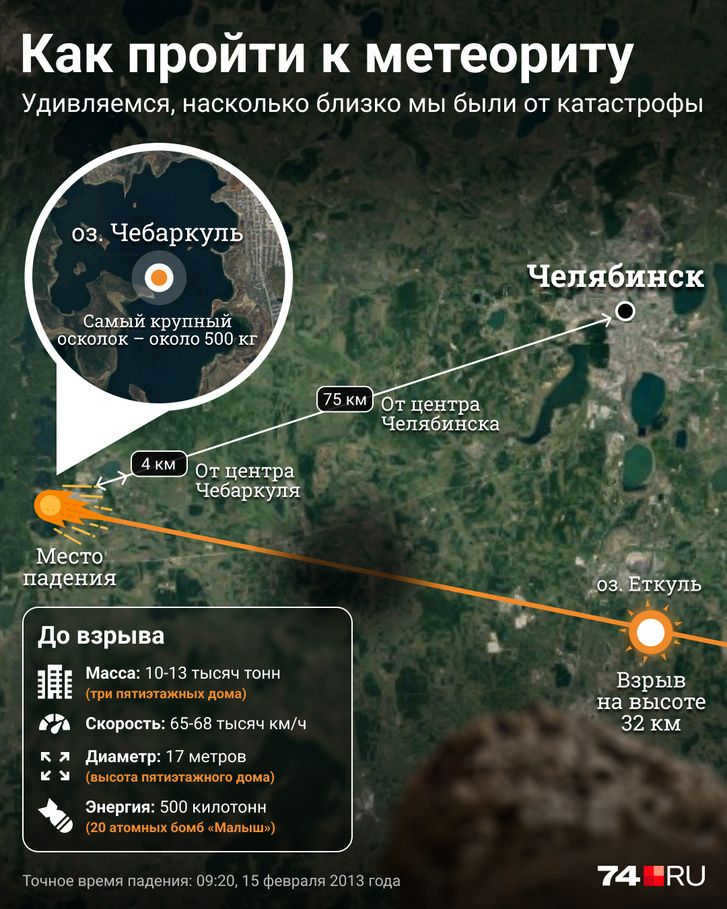
“The excavation took a month and a half”
– “Nikolai Eduardovich, the meteorite fell in winter and we extracted the largest fragment in the fall. Why didn’t we do it immediately?”
– “Work always seems easy once it’s already done. As I recall the incident, the military was the first to arrive at the site. They dived in and their diver almost drowned. Then the lifeguards arrived and their employee also almost drowned. We closely followed this situation and even then we realized that we would need experienced specialists capable of handling complex and dangerous tasks.”

– How did you determine the exact location of the meteorite in the lake?
– We conducted research and collected all the data when we arrived at the lake. Initially, we had conversations with locals, but unfortunately, they were not helpful due to the lack of references. However, we were fortunate to meet Nikolai Lavrentievich Melnikov, a resident of the area, who had captured the moment of the meteorite’s fall on his house camera (Editor’s note). Being a former military personnel, he used azimuths to determine the angle between the direction to the north and the selected object (Editor’s note). Using these azimuths and the coastal landmarks, we marked the location on the map. Additionally, we obtained an aerial photograph, which allowed us to further confirm the exact point. By translating this point into geographic coordinates, we were able to pinpoint the location and proceed with our work in that area.

Using an echo sounder, we were able to detect the signal and subsequently spent a month and a half excavating a hole to reach it. The water depth was approximately 9 meters, at which point the silty conditions significantly reduced visibility to zero. We then had to dig an additional 9 meters through the silt, occasionally requiring us to dig even deeper. Despite the challenges, it was relatively easy to retrieve a stone by wrapping it in soft slings and using a winch to lift it up. The stone weighed 654 kilograms, which was not a significant weight for a diver considering we had to lift items that were 800 times heavier.
— I recall that there was a floating platform right on the lake, from which divers would descend.
– On a special platform measuring 6 by 8 meters, which was secured to the bottom, there was a hangar for divers and equipment. The platform had a carrying capacity of 6 tons. The reason for this was that the platform supported surface equipment weighing one and a half tons, as well as underwater structures weighing three tons.

– In short, we were relocating it from one location to another. Chebarkul is a lake known for drinking water, so it was necessary to carefully pump the silt to prevent any harm. When something is taken out of the water, it can have an impact on the plankton and the overall damage to the aquatic environment needs to be assessed.
Overall, the lake remains unchanged – the water remains undisturbed, sediment and nutrients remain untouched, and plankton has not been affected. The removal of a foreign object can be seen as a form of lake cleansing.

– Have you encountered any disturbance from enthusiasts of fragment collecting who were eagerly searching for remnants of the meteorite’s impact?
– No, the frenzy of collecting pebbles from the meteorite fall has already died down. However, we did have to deter people on motorboats. Fortunately, we were accompanied by the GIMS (State Inspectorate for Small Vessels of the Ministry of Emergency Situations of Russia) and rescuers, who ensured that the boats did not disrupt the divers’ work. We are immensely grateful to them for protecting us from the curiosity of others.
There was, however, an incident. One day, when we arrived, we discovered that all our underwater equipment had been overturned, bent, and slings had been cut. Apparently, someone assumed that we were storing the rocks we found there. Ironically, that area was actually the pump exhaust. We had to spend a significant amount of time repairing the damage.
– It was a great surprise to us when we were able to visually detect the meteorite using the echo sounder. In theory, echo sounders should not be able to detect anything at the depth of the mud. Additionally, in mid-September, we created a 3D model of the meteorite based on initial surveys and shared it with the client. A month later, in mid-October, we successfully retrieved the stone and found that it perfectly matched the 3D model. This unexpected and delightful success continues to amaze us and is something we take great pride in. The rest is simply the result of hard work.

“The governor has arrived – we are delighted”
— It is widely known that there are still many individuals who hold the belief that it was not a meteorite, but a rocket. What are your thoughts on this hypothesis and other theories?
– Why not? In their time, stone axes existed. There are individuals who have faith in stone rockets. Well, and we were thoroughly satisfied with the explanations provided by the “experts”, why there is no stone present, along with stories about extraterrestrial beings – green men (smiles). The locals had no doubts that some of them are residing at the bottom, entwined with the stone. We did not even engage in arguments – our positive mindset greatly aided us in our endeavors.

There were numerous speculations circulating. Reports emerged claiming that the stone had been located and that illegal money laundering activities were taking place. We chose not to respond to these rumors. It becomes impossible to engage in a discussion when individuals who lack understanding of the intricacies of diving work begin to debate its speed and cost.
As soon as we spotted the meteorite on our instruments, any doubts vanished. It became clear that we needed to take action. Interestingly, on the day the stylus detected the meteorite, there was a mysterious occurrence. Two out of the three pumps responsible for removing the sludge malfunctioned. The guys made jokes, suggesting that the intelligent sapropel was reluctant to release the meteorite.
— How did the officials react? Did they make demands, impose restrictions, or exert pressure?
When the initial discoveries were made (divers retrieved 12 fragments, five of which, including a 4.8-kilogram piece, were identified as meteorites. – Ed.), we had reached the end of the contractual timeframe. The delays were caused by weather conditions and the need for approvals. I approached the clients and informed them, “We need to request an extension.” Their only concern was, “Are you certain that the stone is present?” I confidently replied, “Absolutely,” and that settled it – they agreed to extend the contract until the end of October. And we were able to expedite the retrieval process.

– Did you have to wait a little for Mikhail Yurevich, as it is true that the governor’s participation was a mandatory requirement for lifting the meteorite?
It was clear that the authorities and TV crews would have arrived by that time. All the media were already present in the vicinity. The governor showed up – great, we were happy about it. However, there were no associated delays.

– Has the hole that was dug 10 years ago been filled with silt?
– Yes, it has, but it’s uncertain how much. Three meters of silt have completely filled the hole. The structure itself has been preserved, however, we sealed off the tunnels that led to it to prevent anyone from accidentally falling in. We made a special trip in the winter, even though it wasn’t required by our contract. But there will always be plenty of curious people. During the summer, divers of all types, experienced and inexperienced, will venture there at the risk of their lives. And I am familiar with how the flight investigation system operates in Russia.
– Did you and your fellow divers take a piece of the meteorite as a memento?
– Perhaps they believed that you had caught and cut your own stones.
– Well, I can only say that it reflects more on the people who have such thoughts, rather than on us.
– Did you visit the meteorite at the museum?
– We did once, after the ascent. We don’t have any special attachment to it. It’s understandable that it weighs differently now since they removed some extra pieces and only kept the largest one. I handed over a stone that weighed 654 kilograms. What happened to it on the way, and any issues involving sawing or criminal cases, is not our concern.

– What was the most memorable operation to recover the Chelyabinsk meteorite?
– We had an exceptional team, and we put in a tremendous amount of effort and enthusiasm into the recovery. And we didn’t gain anything from it (laughs). The weather was dreadful, and the conditions were incredibly challenging. We pushed the boundaries of acceptable risk more than we should have. After 10 years, we have gained more wisdom. If we were to do the recovery now, we would double the safety precautions, work for a longer period of time, and approach it slightly differently.
– You mentioned that the price for lifting the meteorite was too low. It was reduced from 3 to 1.67 million rubles at the auction. Why did you decide to participate in the auction?
– The cost was completely inadequate for the complexity of the task, but I really wanted to be a part of it. We negotiated below the actual cost, as it was mainly a PR stunt. We had already completed enough projects that year and felt that we could afford to dedicate a couple of months to this endeavor.
– So, how did it benefit your reputation? How do you feel about the outcome after 10 years?
– It has been great! It has saved us a lot of time in dealing with clients. Previously, we would have to emphasize our expertise and reputation as well-known specialists in our field, particularly among divers. Now, we simply mention that “We lifted the Chelyabinsk meteorite” and all doubts or questions are instantly resolved.

– Have you ever caught any other celestial objects?
– We haven’t caught any meteorites, but we conducted a survey in Lithuania last year. If we have enough funds, we might be able to retrieve a Lithuanian meteorite next year or in the future. There is a similar situation where a space rock fell into a lake over 100 years ago. However, there is limited data available, so extensive search efforts are needed.
– Why do these celestial bodies keep falling into lakes?
– Nikolai Eduardovich, besides lifting the meteorite, what other landmark projects have you been involved in?
– We have completed some impressive projects, but unfortunately, we cannot disclose all of them due to contractual obligations. One recent case involved the clearance of a flooded underground tunnel at an old factory. This tunnel, which was constructed 50 years ago, spans 200 meters in length and does not have any side passages. The water temperature in the tunnel was below 40 degrees Celsius, which is quite unusual. Surprisingly, working in cold water is actually more preferable than in warm or hot water, as it is easier to protect oneself from the cold. This particular project was truly unique, as it required both underground and underwater work, with access through a well. It required the skills of a highly experienced industrial diver!
Currently, I find myself in Chile. The topic of conversation centered around potential job opportunities, all while enjoying a relaxing vacation in Atacama – known as the most arid desert on our planet. Rainfall in this region is a rare occurrence, happening only once every few decades. Located on the western coast of South America, this destination has piqued my interest for quite some time.

10 years ago, back in February 15, a meteorite made its descent upon the Urals, specifically in the region known as Chelyabinsk. Experts assert that while it possessed the ability to cause utter devastation to a medium-sized town, it fortunately lacked the capacity to annihilate our entire planet. Miraculously, this celestial “rock” found its way to Lake Chebarkul instead. Although it managed to wreak havoc in Chelyabinsk and instill terror in the nearby city of Yekaterinburg, it ultimately disintegrated upon impact with the reservoir. Astonishingly, countless windows shattered, walls crumbled, and yet not a single soul perished – only injuries were sustained.

“The excavation process lasted for a month and a half”
— Nikolay Eduardovich, the meteorite fell during winter, and the largest fragment was retrieved in the autumn. Why wasn’t it done immediately?
– Tasks always appear simple once they are completed. As I recall the incident, the first ones on the scene were the military. They jumped in, almost causing their diver to drown. Then the lifeguards arrived: they jumped in, almost causing their employee to drown. We closely followed this sequence of events, and even then we understood that we would require specialists with experience in handling high complexity and dangerous situations.

– How did you determine the exact location of the meteorite in the lake?
– We conducted research and collected all the necessary data. However, the information we gathered initially proved to be useless due to the lack of references. Fortunately, we had the opportunity to meet Nikolai Lavrentievich Melnikov, a local resident who had captured the moment of the meteorite fall on his house camera. As a former military personnel, he was able to provide us with azimuths, which are angles between the direction to the north and selected objects. Using these azimuths and coastal landmarks, we were able to pinpoint the location on the map. Additionally, we obtained an aerial photo which further helped us confirm the exact point. By translating this point into geographic coordinates, we were able to proceed with our work in that specific area.

Using an echo sounder, we were able to detect the signal, and then we spent a month and a half excavating a hole to reach it. The water depth was approximately 9 meters, and that’s where the silt began. In such conditions, visibility drops to zero. Additionally, there was an additional 9 meters of silt below, and in certain areas, we had to dig even deeper. Capturing a stone was relatively simple. We carefully wrapped it with soft slings and then used a winch to hoist it up. The weight of the stone, 654 kilograms, was not a significant challenge for a diver, considering we had to lift something 800 times heavier.
I recall that there was a floating platform right on the lake where divers would descend.
A specialized platform measuring 6 by 8 meters, with a carrying capacity of 6 tons, was installed on the lake to accommodate a hangar for divers and equipment. This platform was securely anchored to the lake bed. The platform supported surface equipment weighing one and a half tons, in addition to underwater structures weighing three tons.

– In short, we were relocating it from one location to another. Chebarkul is a lake that is used for drinking water, so we had to be very careful when pumping the silt. If something is taken out of the water, it can have an impact on the plankton, so we had to calculate the potential damage to the aquatic environment.
Overall, the lake remains unchanged – the water remains in its original position, silt and nutrients remain undisturbed, and the plankton population remains unharmed. The removal of a foreign object can be viewed as a form of lake cleansing.

— Have you experienced any inconvenience due to enthusiasts of collecting fragments who hurried along the paths of the meteorite’s fall?
– No, the peak of interest in collecting pebbles from the fall has already diminished. However, we had to fend off people on motorboats. Thankfully, we had the support of the GIMS (State Inspectorate for Small Vessels of the Ministry of Emergency Situations of Russia) and rescuers. They ensured that the boats did not ride over the heads of the divers during our work. We are very grateful to them for protecting us from curious individuals.
There was, however, an incident. One day, we arrived and discovered that all our underwater equipment had been overturned, bent, and slings were cut. Apparently, someone believed that we were storing the rocks we had found there. In reality, that area was just a pump exhaust. We had to spend a significant amount of time repairing the damage.
– It was a moment of great astonishment for us when we managed to “visualize” the meteorite using the echo sounder. In theory, echo sounders are not supposed to detect anything at such a depth in the mud. Additionally, in mid-September, after conducting our initial surveys, we created a 3D representation of the meteorite and presented it to the client. Remarkably, when we finally retrieved the stone a month later in mid-October, it perfectly matched our 3D model. This unexpected and immensely satisfying achievement continues to amaze us and is something we take great pride in. The rest of the process was simply a result of hard work.

“There are individuals who have faith in rocket ships.”
— It is common knowledge that numerous individuals still hold the belief that it was not a meteorite, but rather a rocket. What are your thoughts on this theory and other speculations?
– Why not? In the past, there were stone axes. There are people who have faith in stone rockets. Well, and we found the explanations from “experts” quite satisfying, regarding the absence of stone and the tales about extraterrestrial beings – space aliens (smiles). The locals had no doubts that some of them are sitting at the bottom, embracing the stone. We didn’t even argue – our optimistic mindset greatly aided us in our work.

There were numerous speculations swirling around. Word had it that the precious stone had been unearthed, and now they were merely disguising their illicit money transactions. We paid little attention to these rumors. It’s impossible to engage in a meaningful discussion when people who have no understanding of the intricacies of diving work start debating its speed and cost.
From the moment we laid eyes on the meteorite on our instruments, we were absolutely certain. We knew we had to get to work right away. It was rather mystical that on the same day the detector detected the meteorite, two out of three pumps that were supposed to drain the sludge malfunctioned. The guys jokingly attributed it to the clever sapropel not wanting to relinquish the meteorite.
— How did the officials respond? Did they make any demands, prohibitions, or exert pressure?
After the initial discoveries, which consisted of 12 fragments, divers were able to identify five of them as meteorites. One of these fragments weighed 4.8 kilograms and was officially recognized as a meteorite. This information caused us to exceed the original time frame outlined in the contract. The delays were primarily due to unfavorable weather conditions and the need for various approvals. In order to address this issue, I approached the customers and proposed an extension to the contract. They sought reassurance by asking me, “Are you certain that the meteorite is present?” I confidently replied, “Absolutely,” and they agreed to extend the contract until the end of October. As a result, we were able to expedite the retrieval process.

— Has the hole that was dug 10 years ago been filled with silt?
– Yes, it has. However, it is uncertain how much silt has filled the hole. Exactly three meters of silt have settled into the hole, preserving its shape. We have also sealed off the tunnels that lead to it to prevent any accidental falls. We made a special trip in winter, even though it was not required by the contract. But there will always be a lot of curious people. In the summer, divers of all kinds, with varying levels of experience, will go there and risk their lives. And I am familiar with how the flight investigation system operates in Russia.
— Did you and your fellow divers take a piece of the meteorite as a memento?
– Maybe they assumed that you had caught and sawed your own meteorite.
– Well, there isn’t much to say about those people who think that way, it reflects more on them than on us.
– Have you ever been to the museum to see the meteorite?
– Yes, we went once, after we climbed. There’s no special significance to us. It’s understandable that it weighs differently: they removed the extra pieces and kept the largest one. I handed over a stone weighing 654 kilograms. What happened to it on the way, whether there were any money laundering or criminal cases involved – it’s not our concern.

— What made the operation to lift the Chelyabinsk meteorite remarkable?
– We had an exceptional team, we accomplished all the tasks with enthusiasm and determination. And we didn’t gain anything from it (laughs). The weather was horrendous, the conditions were extremely challenging. We pushed the boundaries of reasonable risk more than we should have. After 10 years, we have gained wisdom. I believe that if we were to do the ascent again, we would double the safety measures, work longer, and approach it slightly differently.
You mentioned that the price for lifting the meteorite was too low. It was reduced from 3 to 1.67 million rubles at the auction. What made you decide to participate in the auction?
– The price was completely inadequate for the difficulty of the task, but I was eager to take part. We negotiated a lower price, which turned out to be a great PR move. We managed to complete enough work with the money we received that year, and we figured we could afford to spend a couple of months on improving our reputation.
How did it benefit your reputation? How do you feel about the outcome after 10 years?
– It was fantastic. It saved us a lot of time in dealing with clients. Previously, we had to prove ourselves as professionals and renowned experts in our field, especially among divers. But now, we just mention that we lifted the Chelyabinsk meteorite, and all doubts disappear.

– Have you ever had the chance to capture any other celestial objects?
– We haven’t managed to capture any meteorites yet, but last year we conducted a survey in Lithuania. Perhaps next year, or in the future, if we have enough funding, we will be able to retrieve a meteorite from Lithuania. There is a similar case where a space rock fell into a lake over 100 years ago. However, there is limited data available, so it would require extensive efforts to search for it.
– Why do these celestial objects keep falling into lakes?
– Nikolai Eduardovich, besides lifting the meteorite, what other landmark projects have you been involved in?
– We have completed some remarkable projects, but due to contractual obligations, not all of them can be disclosed. Recently, we had an interesting case where we were tasked with clearing a submerged underground tunnel at an old factory. This tunnel, which was constructed 50 years ago, spanned 200 meters in length and did not have any side passages. The challenging aspect was the water temperature, which was below 40 degrees Celsius (!). Surprisingly, working in cold water is more preferable than warm or hot water because it is easier to protect oneself from the cold. This project was truly exceptional as it required underwater and underground work simultaneously, with entry through a well. It truly showcased the expertise of a highly skilled industrial diver!





